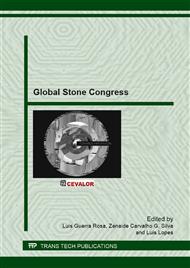[1]
C. Marinosci, P.A. Strachan, G.L. Morini: Empirical validation and modeling of a naturally ventilated rainscreen facade building, Energy and Buildings, Vol. 43 (2011), Issue 4, pp.853-863.
DOI: 10.1016/j.enbuild.2010.12.005
Google Scholar
[2]
M. Mora Perez, G. Lopez Patino, M.A. Bengochea Escribano, P.A. López Jiménez: Quantification of ventilated facade efficiency by using computational fluid mechanics techniques, Boletin de la sociedad Espanola de cerámica y vidrio, Vol. 50 (2011).
DOI: 10.3989/cyv.142011
Google Scholar
[3]
M. Ciampi, F. Leccese, G. Tuoni: Ventilated facades energy performance in summer cooling of buildings, Solar Energy, Vol. 75 (2003), Issue 6, pp.491-502.
DOI: 10.1016/j.solener.2003.09.010
Google Scholar
[4]
A. Jain, A.Y. Yi, X. Xie and R Sooryakumar: Finite element modelling of stress relaxation in glass lens moulding using measured, temperature-dependent elastic modulus and viscosity data of glass, Modelling and Simulation in Mat. Science and Eng. Vol. 14, Issue 3 (2006).
DOI: 10.1088/0965-0393/14/3/009
Google Scholar
[5]
N. Zhang, C. C. Fu, H. Chec: Experiment and numerical modeling of prestressed concrete curved slab with spatial unbonded tendons, Eng. Structures, Vol. 33 (2011), p.747–756.
DOI: 10.1016/j.engstruct.2010.11.029
Google Scholar
[6]
Q. Dai: Three-Dimensional Micromechanical Finite-Element Network Model for Elastic Damage Behavior of Idealized Stone-Based Composite Materials, Journal of Eng. Mec., Vol. 137 (2011), Issue. 6, pp.410-421.
DOI: 10.1061/(asce)em.1943-7889.0000239
Google Scholar
[7]
C. Jiang, G. Liu, D. Zhang and X. Xu: FEM Analysis of Grinding Damage Mechanisms for Ceramics Materials, Materials Science Forum, Vol. 532 – 533 (2006), pp.432-435.
DOI: 10.4028/www.scientific.net/msf.532-533.432
Google Scholar
[8]
R.C. Yu, G. Ruiz, A. Pandolfi: Numerical investigation on the dynamic behavior of advanced ceramics. Eng Fract Mech, Vol. 71 (2004), p.897–911.
DOI: 10.1016/s0013-7944(03)00016-x
Google Scholar
[9]
A.F.M. Azevedo, in: Método dos Elementos Finitos, 1ª ed. Faculdade de Engenharia da Universidade do Porto, Portugal, April (2003).
Google Scholar
[10]
P.J. Fanning, T.E. Boothby: Three Dimensional Modelling and full scale testing of stone arch bridge, Computers and Structures Vol. 79 (2001), pp.2645-2662.
DOI: 10.1016/s0045-7949(01)00109-2
Google Scholar
[11]
F. Mollica, L. Ambrosio: The Finite Element Method for the Design of Biomedical Devices, Biomaterials in Hand Surgery, (2009), pp.31-45.
DOI: 10.1007/978-88-470-1195-3_3
Google Scholar
[12]
O.K. Mahabadi, B.E. Cottrell, G. Grasselli: An Example of Realistic Modelling of Rock Dynamics Problems: FEM/DEM Simulation of Dynamic Brazilian Test on Barre Granite, Rock Mech. and Rock Eng., Vol. 43 (2010), p.707–716.
DOI: 10.1007/s00603-010-0092-7
Google Scholar
[13]
W.C. Zhu, C.A. Tang: Numerical simulation of Brazilian disk rock failure under static and dynamic loading, Int. J. of Rock Mech. & Min. Sci., Vol. 43 (2006), p.236–252.
DOI: 10.1016/j.ijrmms.2005.06.008
Google Scholar
[14]
R.S. Camposinhos: Revestimentos em Pedra Natural com Fixação Mecânica: Dimensionamento e Projecto. 1ª ed., Lisboa: Edições Sílabo, (2009), pp.32-38.
Google Scholar
[15]
L. Jacobsson, M. Flansbjer, B. Schouenborg, B. Grelk, A. Smits: Expert System for Dimensioning of Façade Cladding, Global Stone Congress, Alicante, Spain (2010).
Google Scholar
[16]
R.S. Camposinhos, R.P.A. Camposinhos: Dimension stone cladding design with dowel anchorage. Proceedings of the ICE - Construction Materials, Vol. 162 (2009), pp.95-104.
DOI: 10.1680/coma.2009.162.3.95
Google Scholar
[17]
R.S. Camposinhos, P.M. Amaral, L.G. Rosa, V. Pires: Dimension stone cladding design – Dowel Anchorage Design, paper presented at Int. Congress of Dimension Stones (2008), Carrara, Italy, 29th – 31st May, pp.203-207.
Google Scholar
[18]
ANSYS Structural Analysis Guide, ANSYS Release 9. 0, ANSYS Inc., Nov. (2004).
Google Scholar
[19]
V. Pires, P.M. Amaral, L.G. Rosa, R.S. Camposinhos: Slate flexural and anchorage strength considerations in cladding design, Construction and Building Materials, Vol. 25 (2011), Issue 10, pp.3966-3971.
DOI: 10.1016/j.conbuildmat.2011.04.029
Google Scholar
[20]
HALFEN Technical Product Information. Natural stone support systems – facade. FS 10. 1-E (2011).
Google Scholar
[21]
R.S. Hamilton, in: Air Pollution and Damage To Building Stone, Chemical Analysis of Granites From Quarries and Monument, Environmental protection and conservation of the European cultural heritage – proceedings of the EC workshop, Edited by European Commission, Santiago de Compostela, Spain, 28-30 Nov. (1996).
Google Scholar
[22]
M.H.B.O. Frascá, , J.K. Yamamoto, in: Ageing tests for dimension stone - experimental studies of granitic rocks from Brazil, paper present at 10th Congress of the International Association for Engineering Geology and the Environment – Engineering geology for tomorrow's cities, Nothingam, UK, 6th – 10th September (2006).
Google Scholar
[23]
M. Vargas, C. Maqueda, , M.L. Franquelo, J. García Talegón, J.L.P. Rodrígues, in: Chemical Analysis of Granites From Quarries and Monument, Environmental protection and conservation of the European cultural heritage – proceedings of the EC workshop, Edited by European Commission Santiago de Compostela, Spain, 28-30 Nov. (1996).
Google Scholar
[24]
A. Casal Moura, V. Pires: Selecção de rochas ornamentais – Casos de estudo, Arquitectura e Vida, Ed. Loja da Imagem, Issue 88 (2007).
Google Scholar
[25]
V. Pires, L.G. Rosa, V. Infante, P.M. Amaral, A. Pacheco: Effect of dowel Fixing Conditions on Anchorage Rupture Loads and Rupture Angles of two Portuguese Granites, XIII Portuguese Conference on Fracture, (2012) Coimbra, Portugal.
DOI: 10.4028/www.scientific.net/kem.548.255
Google Scholar
[26]
A. Casal Moura, in: Granitos e Rochas Similares de Portugal, Edição Instituto Geológico e Mineiro, Marca - Artes Gráficas, Porto (2000).
Google Scholar
[27]
J.A.R.S. Simão, in: Rochas ígneas como pedra ornamental – Causas, condicionantes e mecanismos de alteração Implicações tecnológicas, PhD thesis, Universidade Nova de Lisboa, Faculdade de Ciências e Tecnologia, Departamento de Ciências da Terra, Lisboa (2003).
DOI: 10.21011/apn.2017.1304
Google Scholar
[28]
A. Moreira: Reconhecimento geológico, estrutural, petrográfico e geoquímico dos granitos de Alpalhão, Gáfete e Quareleiros (Alto Alentejo), in: Estudos, Notas e Trabalhos, Instituto Geológico e Mineiro (1994), Issue 36, pp.103-117.
Google Scholar
[29]
ASTM C 1354-96, Standard Test Method for Strength of Individual Stone Anchorages in Dimension Stone.
Google Scholar
[30]
Pattex TQ500 – Henkel – General Catalogue, (2009/2010).
Google Scholar
[31]
P.M. Amaral, L.G. Rosa, J.C. Fernandes: Fracture toughness of different types of granite. International Journal of Rock Mechanics and Mining Science, Vol. 36 (1999), pp.839-842.
DOI: 10.1016/s0148-9062(99)00041-8
Google Scholar
[32]
1P.M. Amaral, J.C. Fernandes, L.G. Rosa: Weibull statistical analysis of granite bending strength. Rock Mechanics and Rock Engineering, Vol. 41, Issue 6 (2008), pp.917-928.
DOI: 10.1007/s00603-007-0154-7
Google Scholar


